Carbon Isotope Stratigraphy across the Devonian–Carboniferous Boundary in the East Paleo-Tethys Realm, Tibet, China
Abstract
:1. Introduction
2. Geological Setting
3. Materials and Methods
4. Results
4.1. Oxygen Isotope
4.2. Carbon Isotope
4.3. Lithology and Paleoenvironmental Evolution
5. Discussion
5.1. Xainza Area of Tibet
5.2. South China
5.3. Global
6. Conclusions
Author Contributions
Funding
Data Availability Statement
Acknowledgments
Conflicts of Interest
References
- Veevers, J.J.; Powell, C.M. Late Paleozoic glacial episodes in Gondwanaland reflected in transgressive–regressive depositional sequences in Euramerica. Geol. Soc. Am. Bull. 1987, 98, 475–487. [Google Scholar] [CrossRef]
- Veevers, J.J.; Powell, C.M. Permian–Triassic Pangean Basins and Foldbelts along the Panthalassan Margin of Gondwanaland; Geological Society of America: Boulder, CO, USA, 1994. [Google Scholar]
- Frakes, L.A.; Francis, J.E.; Syktus, J.I. Climate Modes of the Phanerozoic; Cambridge University Press: Cambridge, UK, 2005. [Google Scholar]
- Fielding, C.R.; Frank, T.D.; Birgenheier, L.P.; Rygel, M.C.; Jones, A.T.; Roberts, J. Stratigraphic imprint of the Late Palaeozoic Ice Age in eastern Australia: A record of alternating glacial and nonglacial climate regime. J. Geol. Soc. 2008, 165, 129–140. [Google Scholar] [CrossRef]
- Grossman, E.L.; Yancey, T.E.; Jones, T.E.; Bruckschen, P.; Chuvashov, B.; Mazzullo, S.J.; Mii, H.S. Glaciation, aridification, and carbon sequestration in the Permo–Carboniferous: The isotopic record from low latitudes. Palaeogeogr. Palaeoclimatol. Palaeoecol. 2008, 268, 222–233. [Google Scholar] [CrossRef]
- Wang, D.R.; Fen, X.J. Research on Carbon and Oxygen Geochemistry of Lower Paleozoic in North China. Acta Geol. Sin. 2002, 76, 400–408, (In Chinese with English abstract). [Google Scholar]
- Ruhl, M.; Deenen, M.H.L.; Abels, H.A.; Bonis, N.R.; Krijgsman, W.; Kürschner, W.M. Astronomical constraints on the duration of the early Jurassic Hettangian stage and recovery rates following the end–Triassic mass extinction (St Audrie’s Bay/East Quantoxhead, UK). Earth Planet. Sci. Lett. 2010, 295, 262–276. [Google Scholar] [CrossRef]
- Hu, Q.; Cao, J.; Huang, J.H.; Yu, J.X.; Zhang, N.N.; Feng, J.X. Variation of Organic Carbon Isotope and Bio–geochemical Significances across the Permian–Triassic Boundary at Xinmin Section, Guizhou, South China. Geol. Rev. 2011, 57, 305–315, (In Chinese with English abstract). [Google Scholar]
- Takashima, R.; Nishi, H.; Yamanaka, T.; Hayashi, K.; Waseda, A.; Obuse, A.; Mochizuki, S. High–resolution terrestrial carbon isotope and planktic foraminiferal records of the Upper Cenomanian to the Lower Campanian in the Northwest Pacific. Earth Planet. Sci. Lett. 2010, 289, 570–582. [Google Scholar] [CrossRef]
- Dickens, G.R.; O’Neil, J.R.; Rea, D.K.; Owen, R.M. Dissociation of oceanic methane hydrate as a cause of the carbon isotope excursion at the end of the Paleocene. Paleoceanography 1995, 10, 965–971. [Google Scholar] [CrossRef]
- Eyles, N. Glacio–epochs and the supercontinent cycle after ∼3.0 Ga: Tectonic boundary conditions for glaciation. Palaeogeogr. Palaeoclimatol. Palaeoecol. 2008, 258, 89–129. [Google Scholar] [CrossRef]
- Pálfy, J.; Kocsis, A.T. Volcanism of the Central Atlantic magmatic province as the trigger of environmental and biotic changes around the Triassic–Jurassic boundary. Volcanism Impacts Mass Extinct. Causes Eff. 2014, 505, 245–261. [Google Scholar]
- Magaritz, M. 13C minima follow extinction events: A clue to faunal radiation. Geology 1989, 17, 337–340. [Google Scholar] [CrossRef]
- Keith, M.L.; Weber, J.N. Carbon and oxygen isotopic composition of selected limestones and fossils. Geochim. Cosmochim. Acta 1964, 28, 1787–1816. [Google Scholar] [CrossRef]
- Popp, B.N.; Anderson, T.F.; Sandberg, P.A. Brachiopods as indicators of original isotopic compositions in some Paleozoic limestones. Geol. Soc. Am. Bull. 1986, 97, 1262–1269. [Google Scholar] [CrossRef]
- Veizer, J.; Godderis, Y.; Francois, L.M. Evidence for decoupling of atmospheric CO2 and global climate during the Phanerozoic eon. Nature 2000, 408, 698–701. [Google Scholar] [CrossRef]
- Caplan, M.L.; Bustin, R.M. Devonian–Carboniferous Hangenberg mass extinction event, widespread organic–rich mudrock and anoxia: Causes and consequences. Palaeogeogr. Palaeoclimatol. Palaeoecol. 1999, 148, 187–207. [Google Scholar] [CrossRef]
- Kaiser, S.I.; Steuber, T.; Becker, R.T.; Joachimski, M.M. Geochemical evidence for major environmental change at the Devonian–Carboniferous boundary in the Carnic Alps and the Rhenish Massif. Palaeogeogr. Palaeoclimatol. Palaeoecol. 2006, 240, 146–160. [Google Scholar] [CrossRef]
- Kaiser, S.I. The Devonian/Carboniferous boundary stratotype section (La Serre, France) revisited. Newsl. Stratigr. 2009, 43, 195. [Google Scholar] [CrossRef]
- Allegre, C.O.; Courtillot, V.; Tapponnier, P.; Hirn, A.; Mattauer, M.; Coulon, C.; Xu, R. Structure and evolution of the Himalaya–Tibet orogenic belt. Nature 1984, 307, 17–22. [Google Scholar] [CrossRef]
- Yin, A.; Harrison, T.M. Geologic evolution of the Himalayan–Tibetan orogen. Annu. Rev. Earth Planet. Sci. 2000, 28, 211–280. [Google Scholar] [CrossRef]
- Gehrels, G.; Kapp, P.; DeCelles, P.; Pullen, A.; Blakey, R.; Weislogel, A.; Yin, A. Detrital zircon geochronology of pre-Tertiary strata in the Tibetan-Himalayan orogen. Tectonics 2011, 30, 1–27. [Google Scholar] [CrossRef]
- Wu, F.Y.; Wan, B.; Zhao, L.; Xiao, W.J.; Zhu, R.X. Tethyan geodynamics. Acta Petrol. Sin. 2020, 36, 1627–1674, (In Chinese with English abstract). [Google Scholar]
- Xu, Z.; Dilek, Y.; Cao, H.; Yang, J.; Robinson, P.; Ma, C.; Li, H.; Jolivet, M.; Roger, F.; Chen, X. Paleo–Tethyan Evolution of Tibet as Recorded in the East Cimmerides and West Cathaysides. J. Asian Earth Sci. 2015, 105, 320–337. [Google Scholar] [CrossRef]
- Li, J.H.; Wang, H.H.; Li, W.B. Discussion on global tectonics evolution from plate reconstruction in Phanerozoic. Acta Pet. Sin. 2014, 35, 207–218. [Google Scholar]
- Dewey, J.F.; Shackleton, R.M.; Chang, C.F.; Sun, Y.Y. The tectonic evolution of the Tibetan Plateau. Philos. Trans. R. Soc. Lond. Ser. A Math. Phys. Sci. 1988, 327, 379–413. [Google Scholar]
- Murphy, M.A.; Yin, A.; Harrison, T.M.; Durr, S.B.; Chen, Z.; Ryerson, F.J.; Zhou, X. Significant crustal shortening in south–central Tibet prior to the Indo–Asian collision. Geology 1997, 25, 719–722. [Google Scholar] [CrossRef]
- Ding, L. Paleocene deep water sediments and radiolarian faunas implication for evolution of Yarlung Zangbo foreland basin, southern Tibet. Sci. China Ser. D 2010, 33, 47–58, (In Chinese with English abstract). [Google Scholar] [CrossRef]
- Yang, S.P.; Fan, Y.N. Carboniferous brachiopods from Xizang (Tibet) and their faunal provinces. Contrib. Geol. Qinghai–Xizang Plateau 1983, 11, 265–289, (In Chinese with English abstract). [Google Scholar]
- Xia, D.X. Paleozoic strata in Zhongzha area, Beihu area, Tibet. Contrib. Geol. Qinhai–Xizang Plateau 1979, 2, 106–120, (In Chinese with English abstract). [Google Scholar]
- Qu, Y.G.; Wang, Y.S.; Zhang, S.Q.; Wang, Z.H.; Lu, P.; Duan, J.X. New results and major progress in regional geological survey of the Toiba District Sheet. Geol. Bull. China 2004, 23, 492–497, (In Chinese with English abstract). [Google Scholar]
- Wang, X.D.; Sugiyama, T. Permian coral faunas of the eastern Cimmerian Continent and their biogeographical implications. J. Asian Earth Sci. 2002, 20, 589–597. [Google Scholar] [CrossRef]
- Nützel, A.; Mapes, R.H. Larval and juvenile gastropods from a Carboniferous black shale: Palaeoecology and implications for the evolution of the Gastropoda. Lethaia 2001, 34, 143–162. [Google Scholar] [CrossRef]
- Zheng, C.Z.; Wang, Y.S.; Zhang, S.Q. The Carboniferous–Permian biostratigraphic division of Deriangmato–Xialashan of the Xainza area, northern Tibet. J. Stratigr. 2005, 29, 520–528, (In Chinese with English abstract). [Google Scholar]
- Wang, X.D.; Shen, S.; Sugiyama, T. Late Palaeozoic corals of Tibet (Xizang) and West Yunnan, Southwest China: Successions and palaeobiogeography. Palaeogeogr. Palaeoclimatol. Palaeoecol. 2003, 191, 385–397. [Google Scholar] [CrossRef]
- Wang, X.D.; Jiang, H.; Gu, S. Cisuralian–Guadalupian conodont sequence from the Shaiwa section, Ziyun, Guizhou, South China. Palaeogeogr. Palaeoclimatol. Palaeoecol. 2016, 457, 1–22. [Google Scholar] [CrossRef]
- Fedorowski, J. Serpukhovian (Early Carboniferous) Rugosa (Anthozoa) from the Lublin Basin, eastern Poland. Ann. Soc. Geol. Pol. 2015, 85, 221–270. [Google Scholar] [CrossRef]
- Yao, J.X.; Ji, Z.S.; Wu, G.C.; Zan, L.P.; Liu, G.Z.; Jiang, Z.X.; Fu, Y.H. Deri’angma–Xiala section in the Xainza area, Tibet, China: A bridge for the stratigraphic and paleontological correlation between Gondwana and Tethys during the Late Carboniferous and Early Permian. Geol. Bull. China 2007, 26, 31–41, (In Chinese with English abstract). [Google Scholar]
- Ji, Z.S.; Yao, J.X.; Wu, G.C.; Liu, G.Z.; Jiang, Z.T.; Fu, Y.H. The Late Carboniferous conodont Neognathodus fauna in Xainza, Tibet, China, and its significance. Geol. Bull. China 2007, 26, 42–53. [Google Scholar]
- Zhao, T. Collection and requirements of geological samples. Northwestern Geol. 1986, 4, 35–37, (In Chinese with English abstract). [Google Scholar]
- Derry, L.A.; Kaufman, A.J.; Jacobsen, S.B. Sedimentary cycling and environmental change in the Late Proterozoic: Evidence from stable and radiogenic isotopes. Geochim. Cosmochim. Acta 1992, 56, 1317–1329. [Google Scholar] [CrossRef]
- Zuo, J.X.; Tong, J.N.; Qiu, H.O.; Zhao, L.S. Evolution characteristics of carbon isotope composition of early Triassic carbonate rocks in lower Yangtze area. Chin. Sci. D 2006, 36, 109–122, (In Chinese with English abstract). [Google Scholar]
- Ji, W.H. Comprehensive Study on Paleozoic Tectonic–Lithofacies Paleogeography of Qinghai–Tibet Plateau and Its Adjacent Areas; China Geo University Press: Beijing, China, 2014. [Google Scholar]
- Li, X.H.; Wu, G.; Wang, C.S. Paleozoic to mesozoic changes of lithofacies andpaleogeography of the coqen basin, central Tibet. J. Chengdu Univ. Technol. 2001, 28, 331–339. [Google Scholar]
- Zhu, L.D.; Liu, D.Z.; Tao, X.F. Paleogeographic evolution of Carboniferous–Early Permian in Cuoqin area, Tibet. Adv. Earth Sci. 2004, 19, 54–57. [Google Scholar]
- Que, W.K. Response of Sedimentary Geology and Carbon Isotope Records of Lower Carboniferous in Guizhou and Guangxi to Ice Age. China Univ. Geosci. 2011, 1–191, (In Chinese with English abstract). [Google Scholar]
- Cheng, L.R.; Zhang, Y.J.; Zhang, Y.C. New progress of Paleozoic strata research in Xainza area, This is a doctoral thesis, and there is no doi. Tibet. Geol. Bull. 2004, 23, 1018–1022, (In Chinese with English abstract). [Google Scholar]
- Zheng, Y.F.; Wang, F. Stable Isotope Geochemistry; Science Press: Beijing, China, 2010. [Google Scholar]
- Zhu, X.M. Sedimentary Petrology, 4th ed.; Petroleum Industry Press: Beijing, China, 2008. [Google Scholar]
- Wang, Y.H.; Liu, L.B.; Cheng, Z.Y. Oxygen and carbon isotopic composition and diagenesis of carbonate rocks. Geol. Rev. 1983, 29, 278–284, (In Chinese with English abstract). [Google Scholar]
- Stable and radiogenic isotopes. Geochim. Cosmochim. Acta 1992, 56, 1317–1329.
- Meyers, W.J.; Lohmann, K.C. Isotope geochemistry of regionally extensive calcite cement zones and marine components in Mississippian limestones, New Mexico. AAPG Bull. 1980, 64, 750. [Google Scholar]
- Graham, L.E.; Wayne, R. Origin of land plants. Rev. Palaeobot. Palynol. 1994, 81, 339. [Google Scholar]
- Stocker, T.F.; Wright, D.G.; Broecker, W.S. The influence of high-latitude surface forcing on the global thermohaline circulation. Paleoceanography 1992, 7, 529–541. [Google Scholar] [CrossRef]
- Kump, L.R.; Arthur, M.A. Interpreting carbon–isotope excursions: Carbonates and organic matter. Chem. Geol. 1999, 161, 181–198. [Google Scholar] [CrossRef]
- Wang, Z.H. Late Devonian Conodont Biostratigraphy and Its Carbon and Oxygen Isotopic Composition in Western Junggar. Ph.D. Thesis, China University of Geosciences, Wuhan, China, 2016. (In Chinese with English abstract). [Google Scholar]
- Broeker, W.; Maier, R.E. The influence of air and sea exchange on the carbon isotope distribution in the sea. Glob. Biogeochem. Cycles 1992, 6, 315–320. [Google Scholar] [CrossRef]
- Xu, D.Y.; Yan, Z.; Ye, L.F.; Zhang, Q.W.; Sun, Y.Y.; Shen, Z.D. Significance of δ13C anomaly at Devonian/Carboniferous boundary of Muhua section in southern China. Geol. Guizhou 1986, 4, 356. (In Chinese) [Google Scholar]
- Bai, S.L.; Wang, D.R.; Yang, J.J. Application of stable carbon isotope in long–distance stratigraphic correlation of Devonian–Carboniferous and Frasian–Famen boundary layers. J. Peking Univ. Nat. Sci. Ed. 1990, 26, 497–505, (In Chinese with English abstract). [Google Scholar]
- Wu, Y.C.; Bai, Z.Q.; Chang, J.Q. Chemical stratigraphy of Devonian–Carboniferous boundary in Nanbiancun section of Guilin, Guangxi. Geol. Sci. Technol. Inf. 2014, 33, 86–92, (In Chinese with English abstract). [Google Scholar]
- Lu, W.C.; Cui, B.Q. Isotopic stratigraphic curve of Devonian marine carbonate rocks in Ganxi section. J. Sediment. 1994, 3, 12–20, (In Chinese with English abstract). [Google Scholar]
- Qie, W.K.; Wang, X.D.; Zhang, X. Latest Devonian to earliest Carboniferous conodont and carbon isotope stratigraphy of a shallow‐water sequence in South China. Geol. J. 2016, 51, 915–935. [Google Scholar]
- Peng, Z.Q.; Wang, C.S.; Li, H.Z. Sea-level change and carbon isotope excursion on the Devonian-Carboniferous boundary in the southern Guizhou depression. J. Guilin Univ. Technol. 2014, 34, 235–244. [Google Scholar]
- Cramer, B.D.; Saltzman, M.R.; Day, J.E.; Witzke, B.J. Record of the Late Devonian Hangenberg global positive carbon–isotope excursion in an epeiric sea setting: Carbonate production, organic–carbon burial and paleoceanography during the Late Famennian. Usgs 2008, 48, 103–108. [Google Scholar]
- Caplan, M.L.; Marc, B.R.; Grimm, K.A. Demise of a Devonian–Carboniferous carbonate ramp by eutrophication. Geology 1996, 24, 715–718. [Google Scholar] [CrossRef]
- Kumpan, T.; Bábek, O.; Kalvoda, J.; Grygar, T.M.; Frýda, J. Sea–level and environmental changes around the Devonian-Carboniferous boundary in the Namur–Dinant Basin (S Belgium, NE France): A multi–proxy stratigraphic analysis of carbonate ramp archives and its use in regional and interregional correlations. Sediment. Geol. 2014, 311, 43–59. [Google Scholar] [CrossRef]
- Trela, W.; Malec, J. Zapis δ13C w osadach pogranicza dewonu i karbonu w południowej części Gór Świętokrzyskich. Przegląd Geol. 2007, 55, 411–415. [Google Scholar]


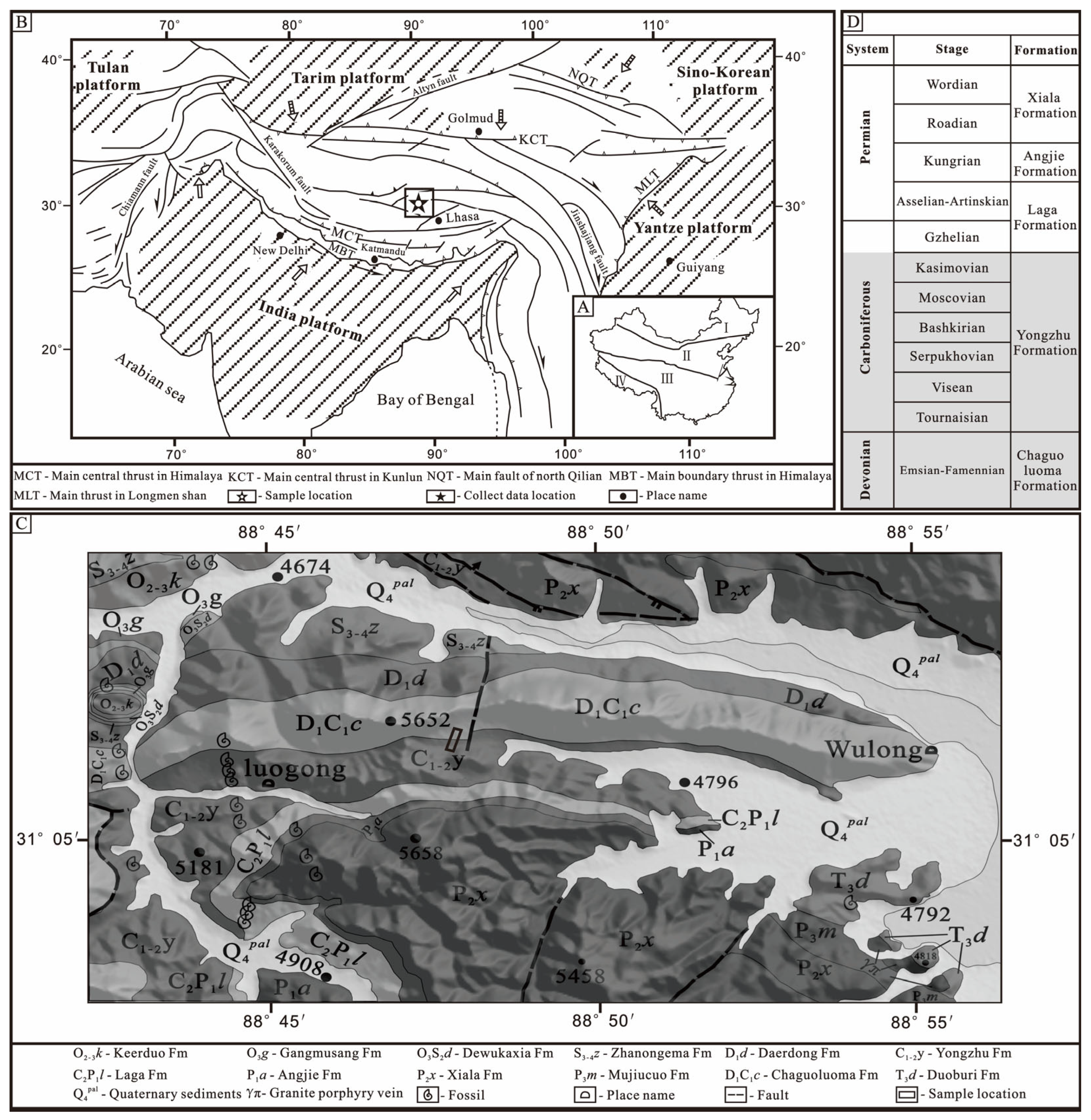
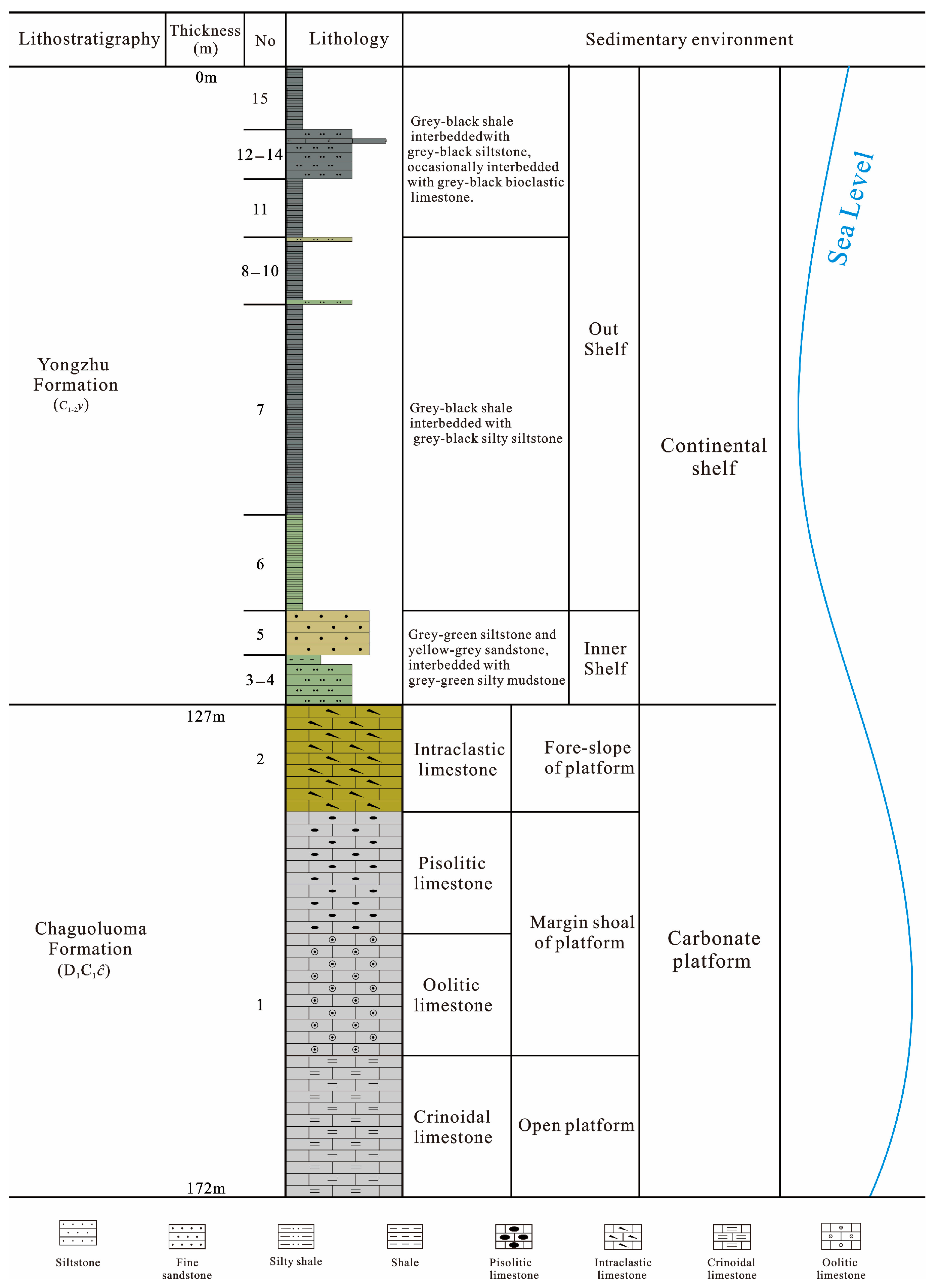
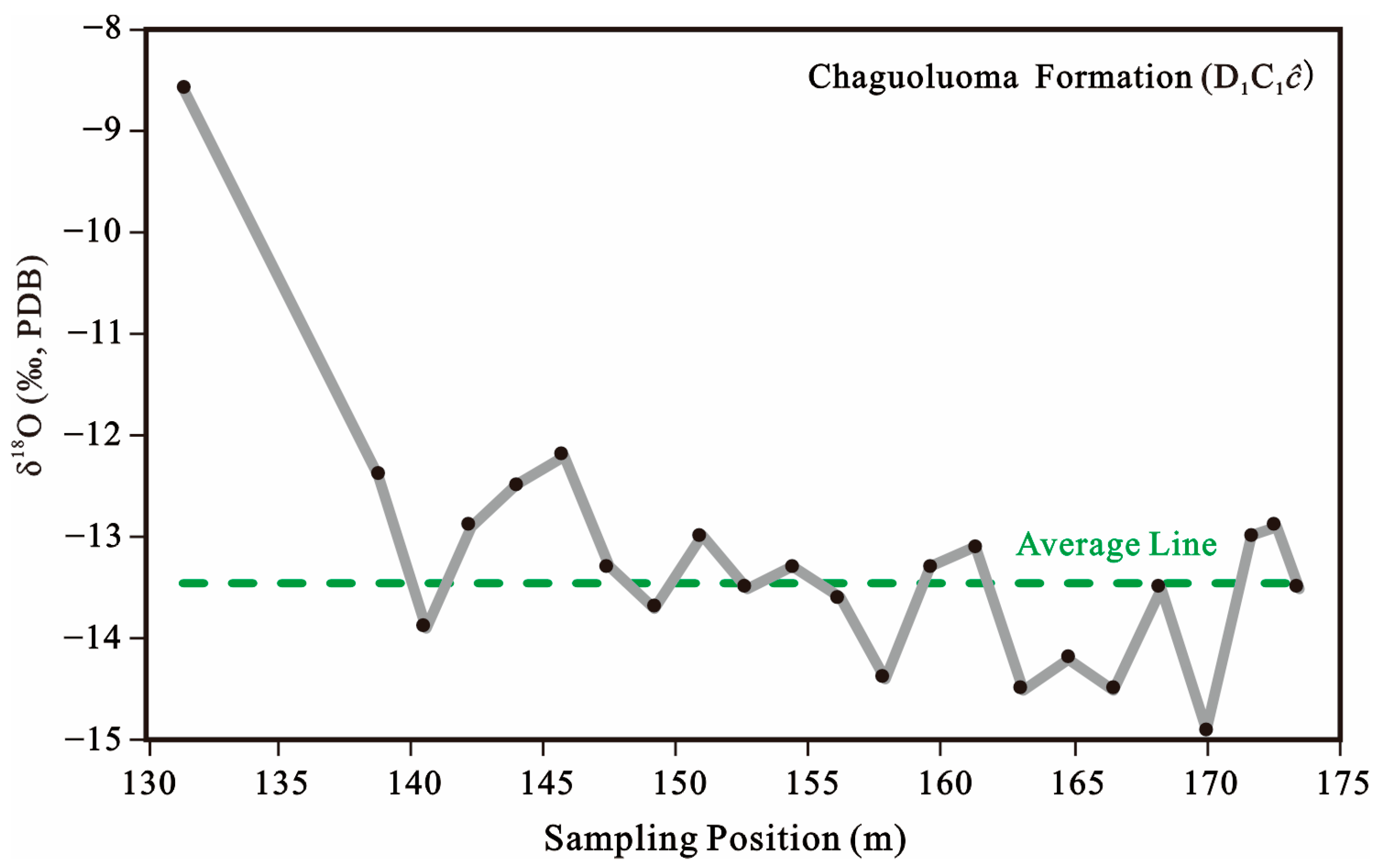
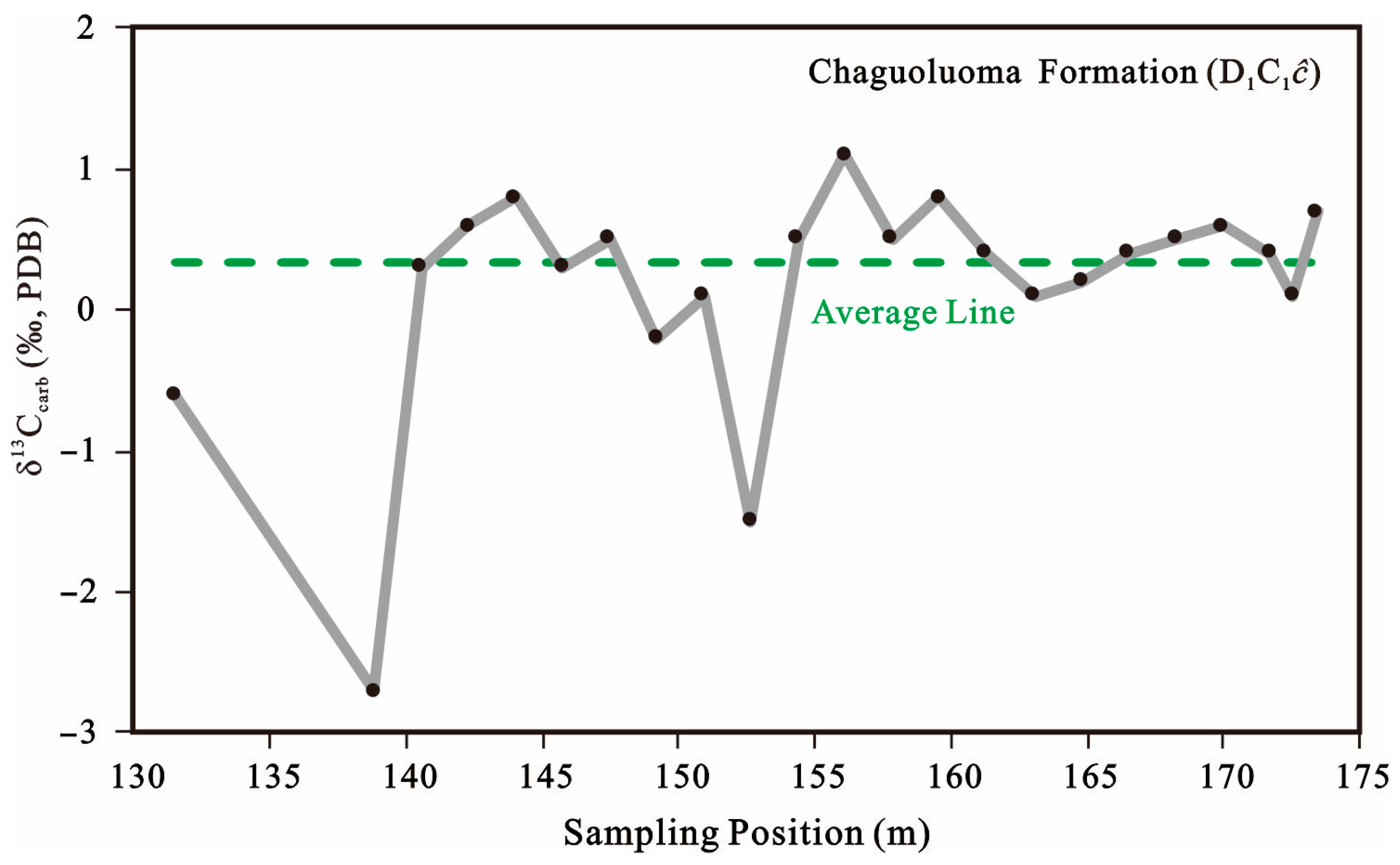

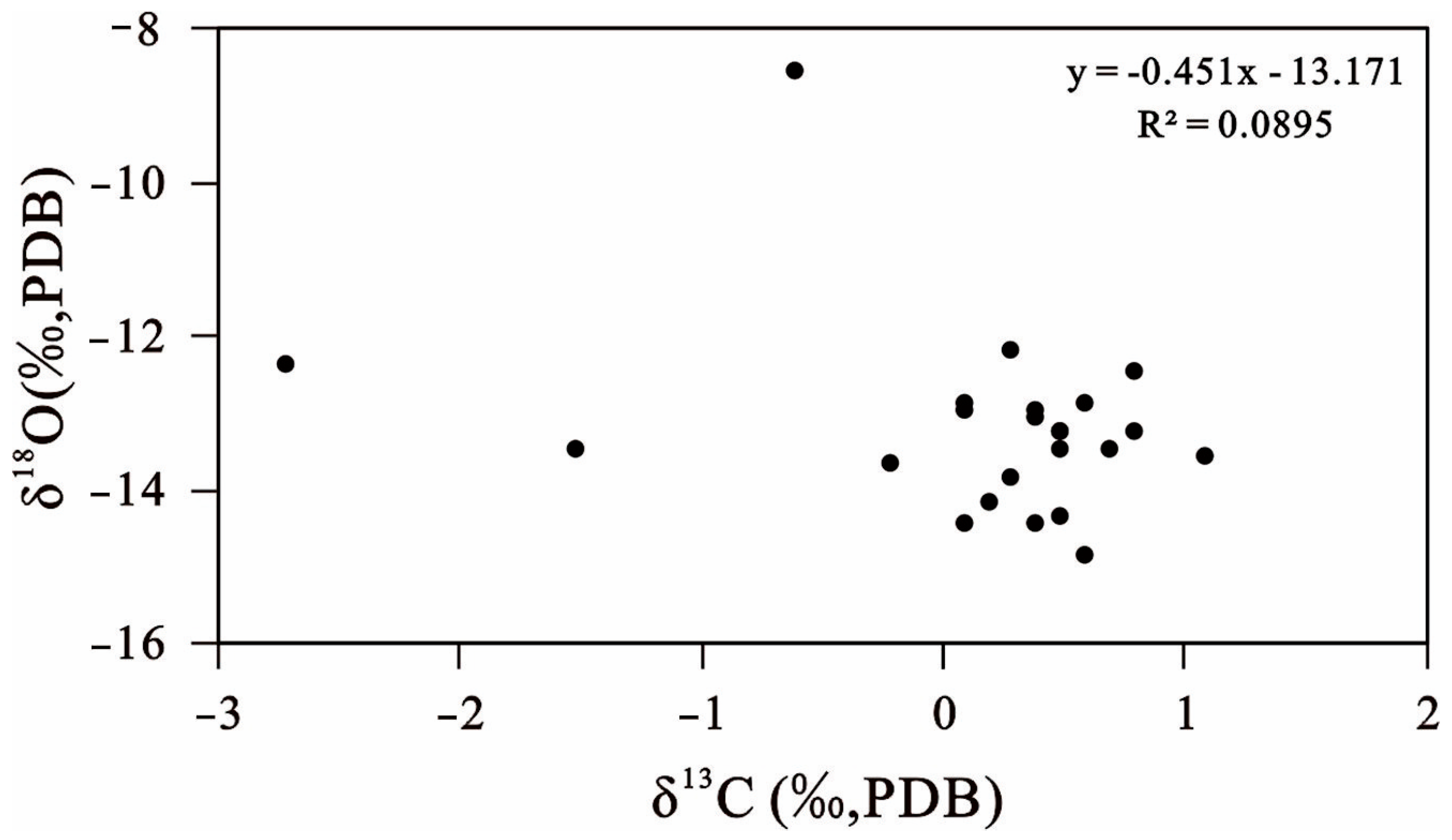
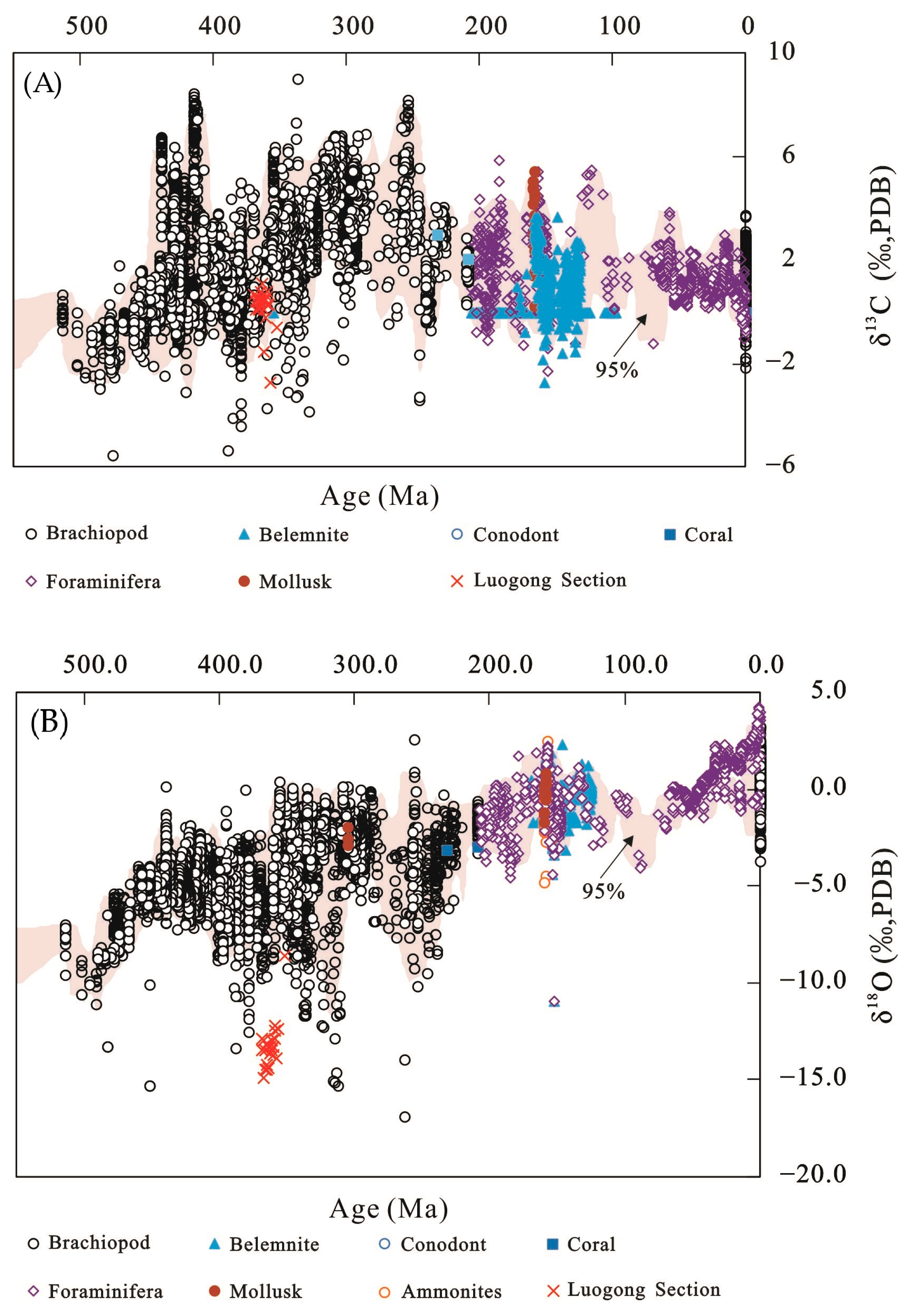
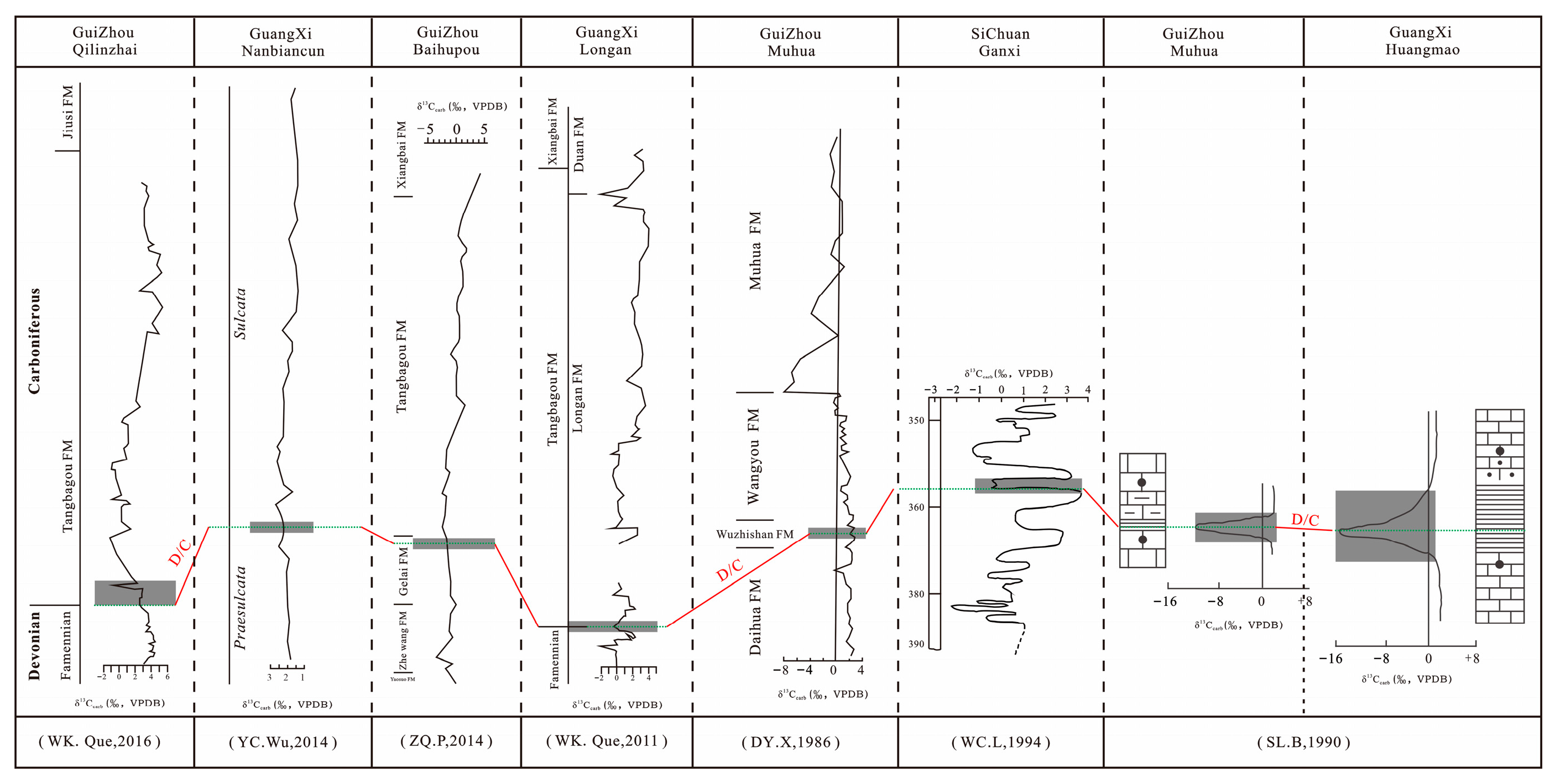
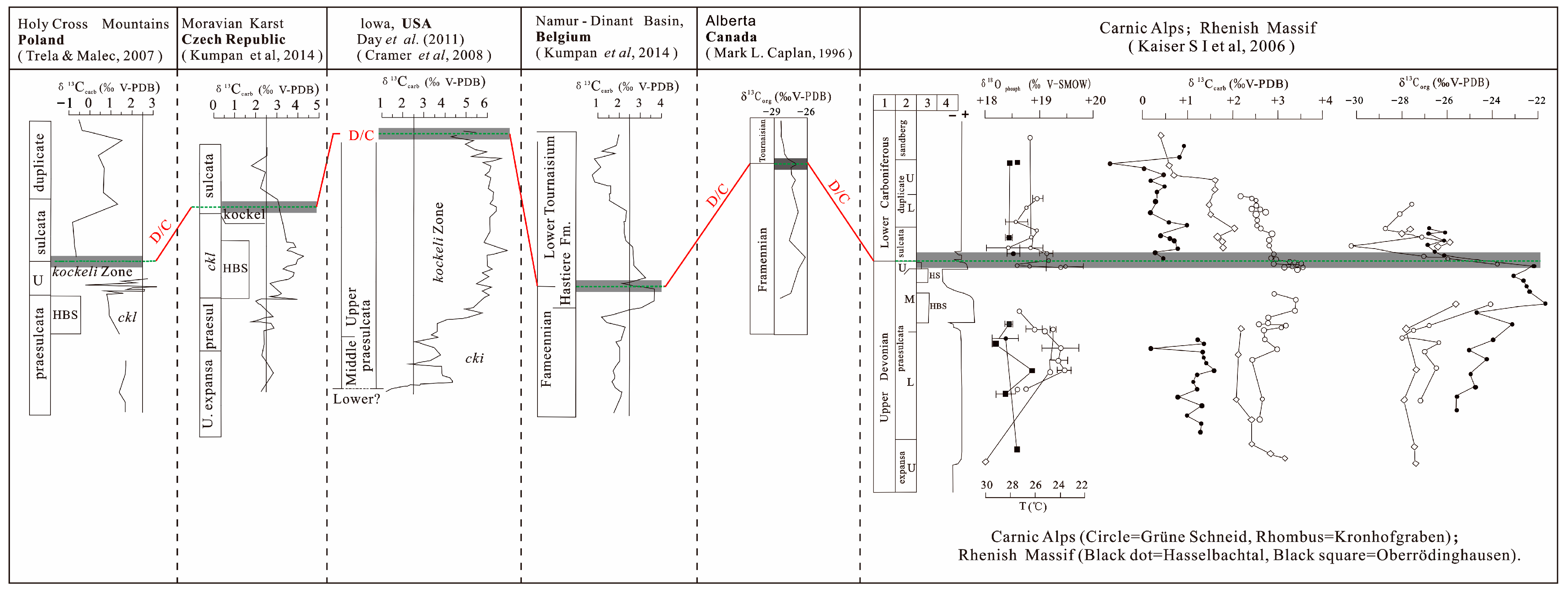
Disclaimer/Publisher’s Note: The statements, opinions and data contained in all publications are solely those of the individual author(s) and contributor(s) and not of MDPI and/or the editor(s). MDPI and/or the editor(s) disclaim responsibility for any injury to people or property resulting from any ideas, methods, instructions or products referred to in the content. |
© 2023 by the authors. Licensee MDPI, Basel, Switzerland. This article is an open access article distributed under the terms and conditions of the Creative Commons Attribution (CC BY) license (https://creativecommons.org/licenses/by/4.0/).
Share and Cite
Cai, Z.; Yi, H.; You, H. Carbon Isotope Stratigraphy across the Devonian–Carboniferous Boundary in the East Paleo-Tethys Realm, Tibet, China. Minerals 2023, 13, 1144. https://doi.org/10.3390/min13091144
Cai Z, Yi H, You H. Carbon Isotope Stratigraphy across the Devonian–Carboniferous Boundary in the East Paleo-Tethys Realm, Tibet, China. Minerals. 2023; 13(9):1144. https://doi.org/10.3390/min13091144
Chicago/Turabian StyleCai, Zhanhu, Haisheng Yi, and Hong You. 2023. "Carbon Isotope Stratigraphy across the Devonian–Carboniferous Boundary in the East Paleo-Tethys Realm, Tibet, China" Minerals 13, no. 9: 1144. https://doi.org/10.3390/min13091144





